Contentment
A fresh loaf of bread
cooling on a wire rack
in time for dinner.

You are currently browsing the Uncategorized category.
A fresh loaf of bread
cooling on a wire rack
in time for dinner.
The weather here has shown an uncharacteristic propensity for white this winter. While she often indulges in her love for the sparkly white of frosts, she usually only dons the honest-to-God white stuff every four or five years. This season, which isn’t over yet, she has waltzed out in the swirly white dress no less than twice.
While I fully intended to make the trek to the farm, it seems that pregnant scooter-riding farmers get a snow day. With the unexpected day off, my thoughts turned to good snow day activities. I was having trouble staying warm… it seems Hemingway is taking all my body heat too. So, instead of going all the way outside, we did our snow activities from the window. While Mr. Quotidian held the window open, I leaned out and made our snow avatars. A tall snowman in Mr. Quotidian’s likeness was easy enough, but I had trouble with the pregnant snowife. So, as a compromise, I fashioned a little Hemingway snowman separately.
Nothing could be more of a soup day than a snow day, so I turned my attention towards dinner. For me, soup must include two things if it’s to be classified as a snow day soup. It must be based on real broth that has been simmering all day, and it must not require any ingredients other than what’s already in my fridge, freezer, or pantry. (Extra points for being able to use leftovers.) The requirements, though they might seem random, actually have some reason behind them. The on-hand ingredients stipulation is for the obvious reason that on a snow day you either can’t or don’t want to make the journey to the grocery store. The broth specification has to do with the anticipation factor. Snow days typically involve long stints under blankets punctuated by brief stints of outdoor frivolity. When I’m home all day, there’s something about slowly becoming aware of the aroma of stock simmering on the stove, attending it throughout the day, and then enjoying the rewards at the end of the day. That pleasure is compounded when my hands are cold from snow and they slowly thaw as I stir the stock, leaning next to a warm stove. Obviously these aren’t real conditions and don’t absolutely have to be followed to have a successful soup. For me, they are just what distinguishes a Snow Day Soup from any other run of the mill soup.
I just happened to have a leftover whole chicken and some rice from last week that was practically begging to be made into soup. In the morning, I picked all the meat from the bones and set the stock to simmer. Later that evening, I sauteed some onions and garlic and stole a few ladle-fuls of the stock, leaving the rest to simmer overnight. I also added a bit of leftover whey to up the protein content (pregnant you know). Because I had time to spare, I added what I consider one of the secret weapons of a good soup: a Parmesan rind. These take awhile to melt in, but can’t be outdone in the savoriness and body they add to soup. When the rind was melted, I added the cooked rice and shredded chicken. Then, at the last minute to preserve its color, I added a couple spoonfuls of homemade pesto. Perfect. Even though I hadn’t been out playing in the snow all day, this soup bore the same sense of comfort and well-being that a hot meal did after my childhood snow days. With this soup, the weather can wear white all she likes.
Snow Day Pesto Chicken and Rice Soup
1 onion, chopped
3 cloves of garlic, grated or chopped
2 Tbs butter
1 quart chicken stock (opt. part whey)
1 hunk Parmesan cheese rind
2-3 cups leftover chicken
1-2 cups cooked rice
2 Tbs pesto
salt and pepper
yogurt, sour cream, creme fraiche
In a medium pot, melt the butter. When is sizzles, add the onions and garlic with a pinch of salt. Stir to coat them with the butter. Let them cook until they start to soften. Add the broth and cheese rind. Bring to a boil, reduce heat to a simmer, cover the pot, and let simmer until the rind is melted into the stock. If you have a few stubborn bits that refuse to melt, just fish them out. Add the chicken and rice and cook till heated through. Right before serving, add the pesto. If you add it too far in advance, it will loose its vibrant green. Taste and season with salt and pepper. Serve with a swirl of yogurt and a dollop of extra pesto.
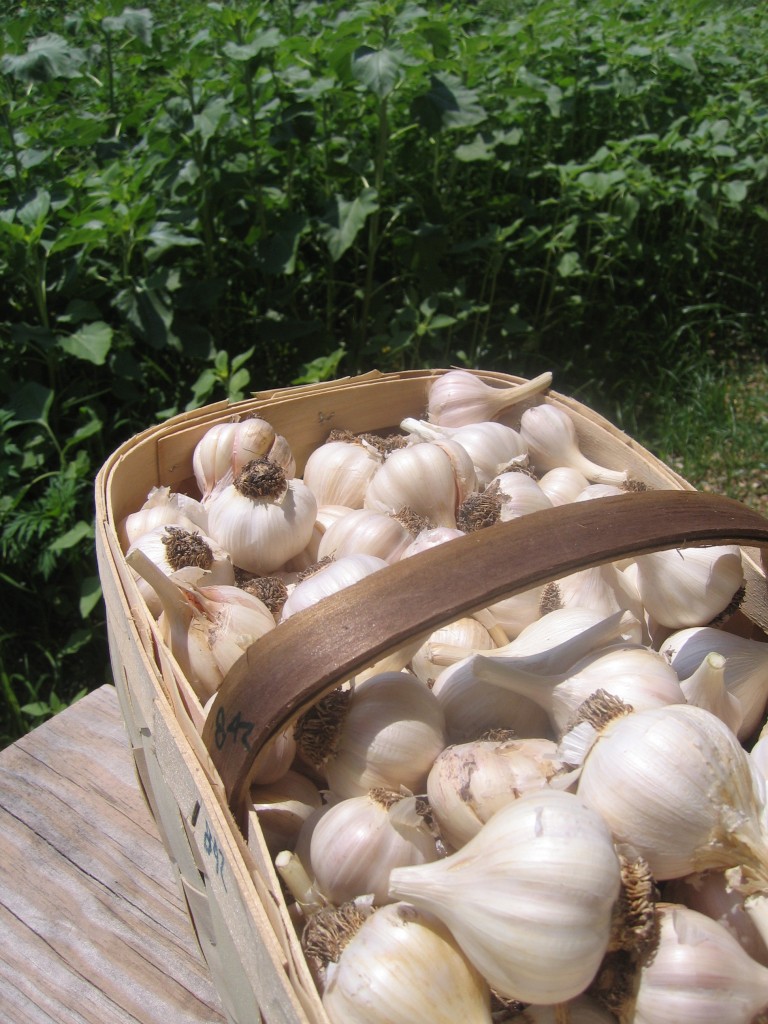 Roasting garlic is so simple and such an easy way to add more depth of flavor to cooking that I don’t know why I don’t do it more often. Garlic’s chemistry allows the cook to manipulate it in different ways, getting a different flavor as a result. Alliin and Allicin, the two volitale compounds in garlic that give it its garlic-ness, are only released when the cell walls are damaged by chopping or chewing. It’s the mixture of these two compounds that give garlic its sharp hot flavor and aroma that many people love in things like hummus. However, other people find raw garlic too harsh but still enjoy the flavor. For cooks, this means that roasting garlic, a method where the cloves stay whole, produces a milder garlic flavor and brings out garlic’s natural sweetness.
Roasting garlic is so simple and such an easy way to add more depth of flavor to cooking that I don’t know why I don’t do it more often. Garlic’s chemistry allows the cook to manipulate it in different ways, getting a different flavor as a result. Alliin and Allicin, the two volitale compounds in garlic that give it its garlic-ness, are only released when the cell walls are damaged by chopping or chewing. It’s the mixture of these two compounds that give garlic its sharp hot flavor and aroma that many people love in things like hummus. However, other people find raw garlic too harsh but still enjoy the flavor. For cooks, this means that roasting garlic, a method where the cloves stay whole, produces a milder garlic flavor and brings out garlic’s natural sweetness.
Roasted garlic is a helpful ingredient to have on hand. You can make a killer garlic bread in a flash by just spreading the garlic onto bread, sprinkling with salt, and toasting for a few minutes. It also adds roasty sweetness to soups and stew that is just not possible to get by simply throwing in chopped garlic. While it does take awhile to make, the prep is very simple and most of the time you can do something else. Also, you can roast as many heads of garlic at one time as you’d like. Once roasted, it will keep for a about a week in the fridge and a few months in the freezer.
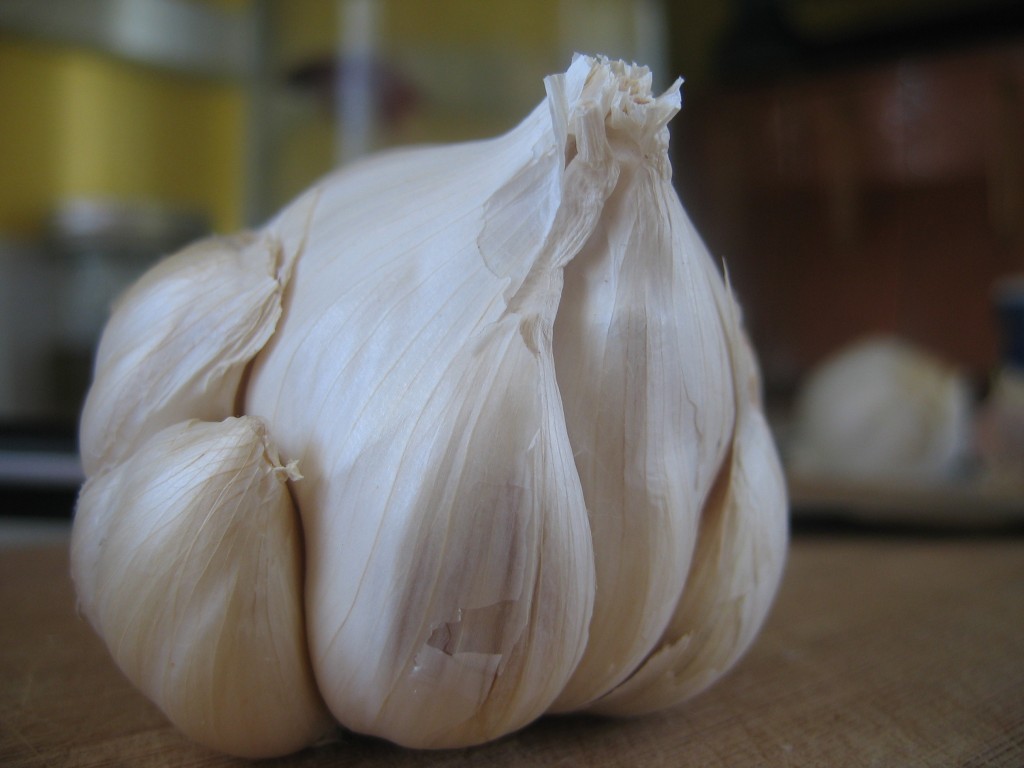 Before you start prepping the garlic, preheat you oven to 400°. Then face your garlic. Begin by peeling off all the loose papery layers. You should be able to see the individual cloves.
Before you start prepping the garlic, preheat you oven to 400°. Then face your garlic. Begin by peeling off all the loose papery layers. You should be able to see the individual cloves.
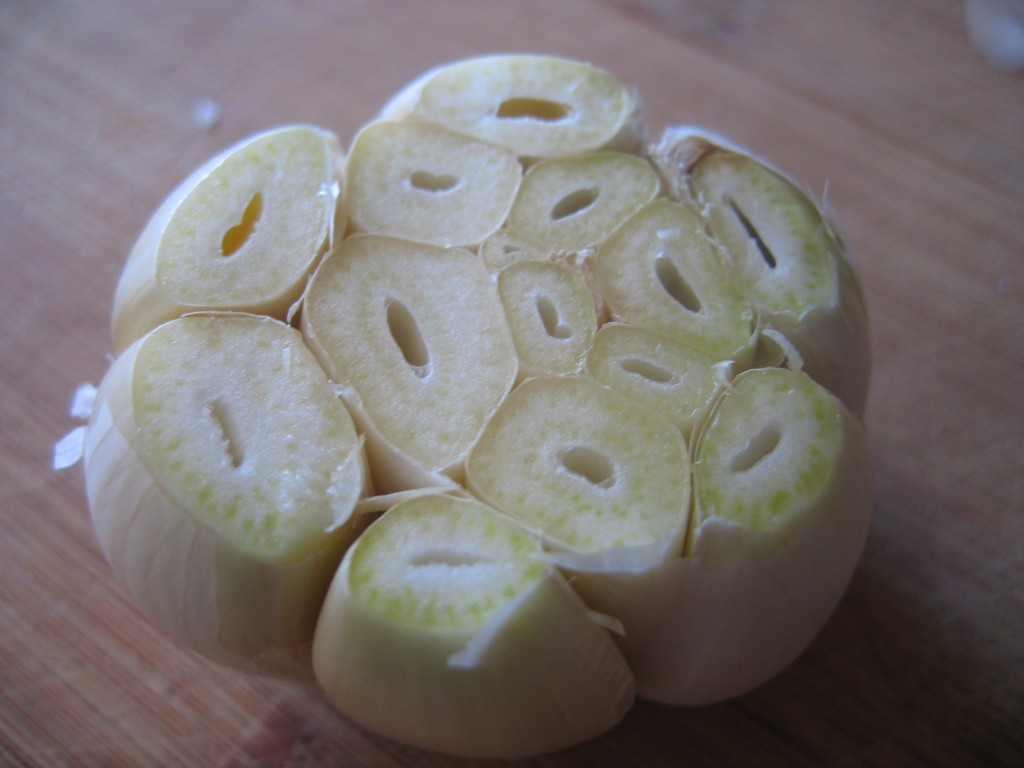 Next, cut the top off the garlic. Once fell chop should take care of most of the cloves. However, if you take the time to cut the tops off any cloves that were missed, you will be rewarded.
Next, cut the top off the garlic. Once fell chop should take care of most of the cloves. However, if you take the time to cut the tops off any cloves that were missed, you will be rewarded.
After the tops are cut off (you could save all the little caps to use later, if you’d like), rub the whole head with olive oil. I know it means getting your hands greasy, but it really is most efficient with your hands. I suppose this could be an excellent job for children….However you accomplish this, the oil rubbed garlic should then go on a baking sheet and into the oven for about 30-40 minutes. Alternatively, you could wrap the heads into little nests of aluminum foil. I just don’t like wasting foil if I don’t have to. I’ve found the baking sheet works just fine. 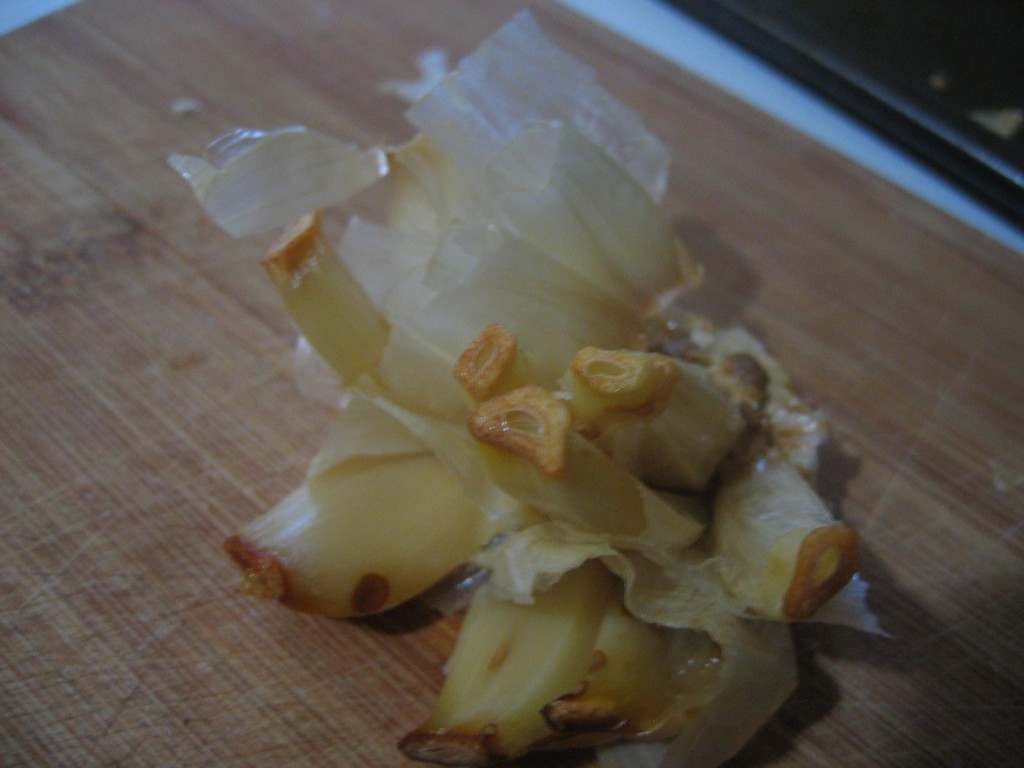 When it’s done, the tops of the cloves should be lightly caramelized, but not burned. Let it cool until you can touch it comfortably. When cool, the garlic should be soft enough that you can press gently on the base of the head and pop all the cloves out. This is where you will be rewarded if you took the time to cut the tops off well. The cloves will slide right out if you’ve cut a big enough hole. If not, well, you’ll get a garlic squirt in the eye. Try it, you’ll see what I mean.
When it’s done, the tops of the cloves should be lightly caramelized, but not burned. Let it cool until you can touch it comfortably. When cool, the garlic should be soft enough that you can press gently on the base of the head and pop all the cloves out. This is where you will be rewarded if you took the time to cut the tops off well. The cloves will slide right out if you’ve cut a big enough hole. If not, well, you’ll get a garlic squirt in the eye. Try it, you’ll see what I mean.
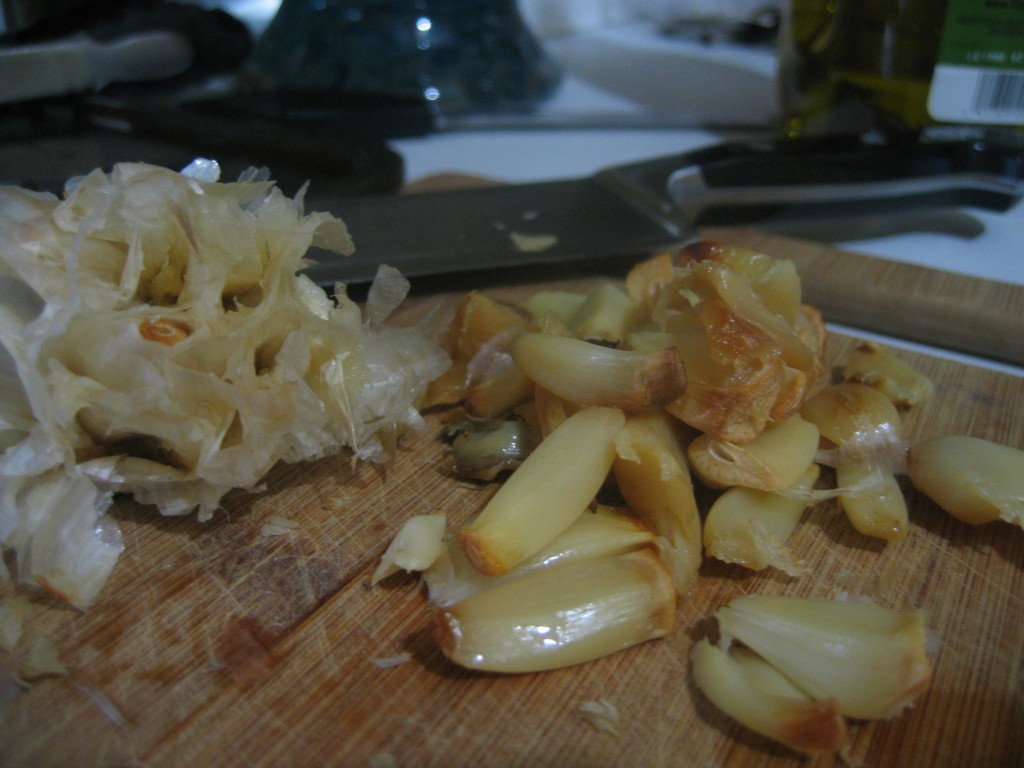 At this point, your roasted garlic is ready to use. Try mixing it with butter or cream cheese for a delicious spread. Make garlic bread, toss into soups, or saute with veggies. I can never resist eating at least one clove by itself, especially after smelling it roast for half an hour.
At this point, your roasted garlic is ready to use. Try mixing it with butter or cream cheese for a delicious spread. Make garlic bread, toss into soups, or saute with veggies. I can never resist eating at least one clove by itself, especially after smelling it roast for half an hour.
Enjoy!
(There are captions, but you have to click the “show info” button)
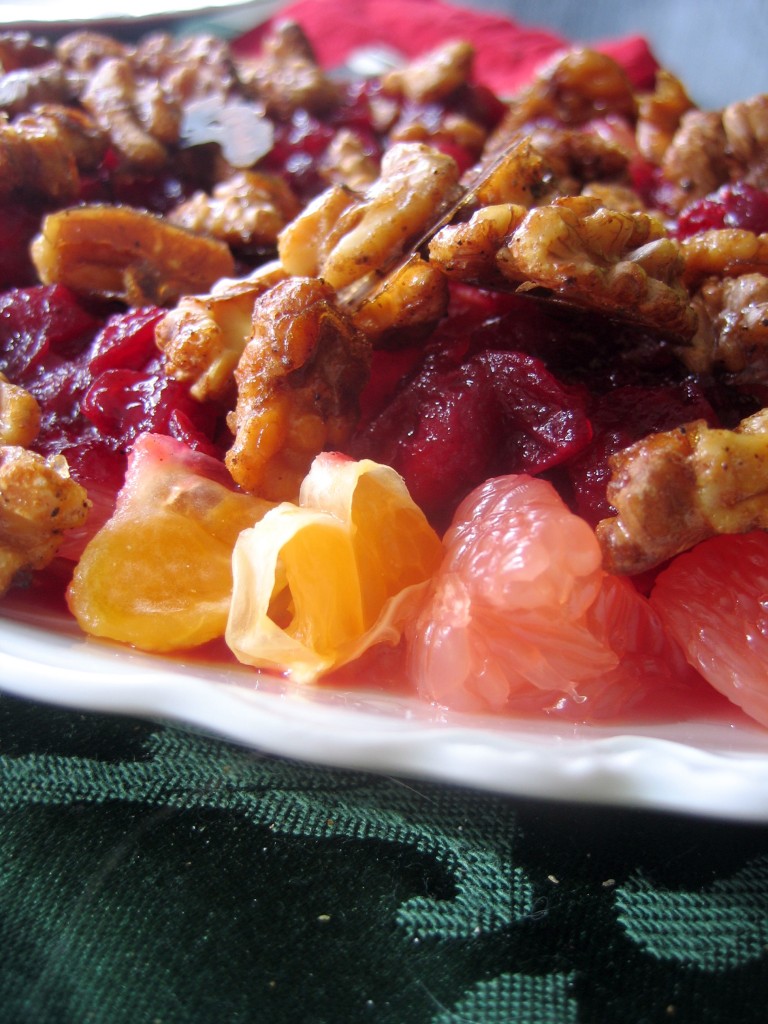 I love citrus. While most cookbooks and online recipe forums seem to think that citrus is best enjoyed in the dog days of summer, I love that it’s true season is actually the mid- winter months. Like a doting grandmother who slips you a bright little foil wrapped piece of candy in that long half hour before dinner, citrus waits till the dark days of winter to ripen.
I love citrus. While most cookbooks and online recipe forums seem to think that citrus is best enjoyed in the dog days of summer, I love that it’s true season is actually the mid- winter months. Like a doting grandmother who slips you a bright little foil wrapped piece of candy in that long half hour before dinner, citrus waits till the dark days of winter to ripen.
While it’s true that citrus isn’t necessarily local, unless you happen to live in Florida, California, or parts of Texas, it is a seasonal fruit, just like anything else. So, while most of us can’t buy citrus from one of our farmer friends, it is still possible to buy it at the peak of its season when it’s freshest, imported the least number of miles, and most importantly– tastiest. For me, that means taking advantage of the natural down time that winter gives us and chowing down on all the grapefruits, tangerines, oranges, clementines, lemons, limes, pomelos, and tangelos I can eat. Peggy Bourjaily wrote an excellent piece for NPR’s Kitchen Window series about this practical locavorism.
Citrus in winter is also a nostalgic thing for me. Truth be told, I would probably eat it in the winter even if it wasn’t in season then. (Conveniently enough though, I get to keep my moral high ground.) As kids, we would always get an orange in the toe of our stocking at Christmas. I don’t know how often we actually ate the orange, but it was of utmost importance that it was there. Since starting our own Christmas traditions, Mr. Quotidian and I have dispensed with the usual stockings filled with odds and ends that end up getting lost or broken in a few weeks. Instead, we leave a pad of paper and pencil by the stockings and write down memories of the other person, then put the memory in the other’s stocking. So, by Christmas morning, we have stockings stuffed with memories. I love the tradition, but obviously an orange would feel rather out of place in such a situation. However, a Christmas without citrus seemed hollow and dull. I realized the easiest way to solve the situation was to serve citrus at one of our Christmas meals. Since citrus doesn’t do well with a cheese fondue, Christmas Eve was out. However, when I remembered a recipe for a salad using oranges and cranberries, Christmas brunch seemed the ideal way to include this jolly, festive fruit. New Year’s brunch would be delicious too…paired with a mimosa perhaps? Continue Reading…
 No other time of year seems to hold as many traditions for me as Christmas. The ornaments get hauled up from the basement, the dust blown off the old pear boxes they’re stored in. Each is carefully unswaddled from its nest of ten year old paper towel and hung on the tree. Little Bethlehems are constructed throughout the house, forming a kind of Yuletide suburban sprawl. Each of the mangers stay empty until Christmas morning. The soundtrack changes frequently as each of us takes our turn choosing our favorite music. Little Brother with Mannheim Steamroller, me with Bing Crosby and Ella Fitzgereld, Mom with hymns.
No other time of year seems to hold as many traditions for me as Christmas. The ornaments get hauled up from the basement, the dust blown off the old pear boxes they’re stored in. Each is carefully unswaddled from its nest of ten year old paper towel and hung on the tree. Little Bethlehems are constructed throughout the house, forming a kind of Yuletide suburban sprawl. Each of the mangers stay empty until Christmas morning. The soundtrack changes frequently as each of us takes our turn choosing our favorite music. Little Brother with Mannheim Steamroller, me with Bing Crosby and Ella Fitzgereld, Mom with hymns.
And then there are the nine different tins of Christmas cookies piled on the counter. Their colors a hodgepodge of cheery greens, wintery blues, rich reds, and ornate golds. Inside each tin is a different cookie– mixing of different cookies into the same tin is strictly forbidden. The cookies range from simple peanut clusters that take just minutes to make to Springerale cookies that get printed with a special rolling pin, cut apart, then left out to dry overnight. Chocolate pinwheels look fancy but are easy to make. Of course sugar cookies make their appearance, the amount of frosting and sprinkles adorning Rudolph’s antlers directly correlating to the age of the person who decorated them.
Somewhere in that pile of tins lies the gingerbread men. These always arrived with grandma’s return address on the box. There was exactly one gingerbread cookie per person. But we never thought we were getting jipped. These weren’t just any gingerbread cookies. As a child, they were as big as my face. I know this because I did it . . . holding the cookie up to my face and inhaling the sweet spicy scent. And they were intricately decorated with all different colors of frosting. The gingerbread men had textured vests and pants. The gingerbread girls had striped skirts and braids that looked almost real. They were the kind of cookies that the children in “The Night Before Christmas” dreamed about. Because they were so big, these cookies were eaten piecemeal . . . an arm or a leg at a time. Each of of us had a different method of decimating our cookie. I worked in a clockwise pattern starting with the head. Continue Reading…
Sweet Potatoes. They aren’t just Thanksgiving food for us anymore. No longer are they like batty Aunt Helga who only gets invited around for holiday dinners for fear of what she might say. And even then, her peculiar ravings get smothered under a sweet blanket of “Yes Aunt Helga, dear” and “How nice you look today dear Aunt Helga” or “Have some more sweet potatoes topped with marshmallows Aunt Helga dear.”
No more. With this recipe begins a new era where sweet potatoes are invited to regular family dinners, like Mexican Night or Italian Night (sweet potato gnocchi, anyone?). Who knows, sweet potatoes might even score an invite to Pizza Night. Continue Reading…
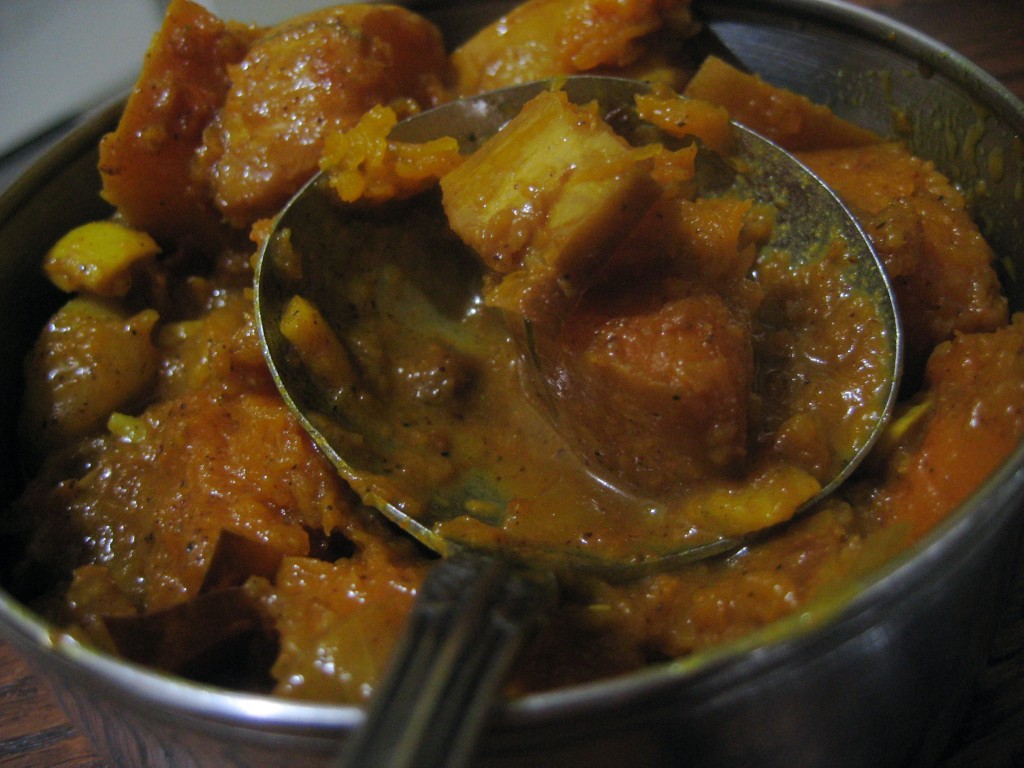 Technically, winter squash season started several weeks ago when we harvested our first batch of butternuts. It was one of those winsome moments in farming; so picturesque that it doesn’t seem possible that it’s real. A garden cart brimming with rosy-golden squash.
Technically, winter squash season started several weeks ago when we harvested our first batch of butternuts. It was one of those winsome moments in farming; so picturesque that it doesn’t seem possible that it’s real. A garden cart brimming with rosy-golden squash.
Even though we harvested the butternut squash several weeks ago, I’ve been waiting to use them until Autumn finally revealed herself. So it’s lucky that winter squash like these keep perfectly on the counter for several months because Autumn seemed to be even more of a procrastinator than usual this year.
In my family, winter squash were generally sweet things–dusted with brown sugar and dotted with raisins. However, inspired by my friend Kristen’s savory submission to a recent potluck, I decided to try a curry. The spices serve as a counterpoint to the squash’s natural sweetness. It seemed a mantle to grace Autumn’s sunburnt shoulders.
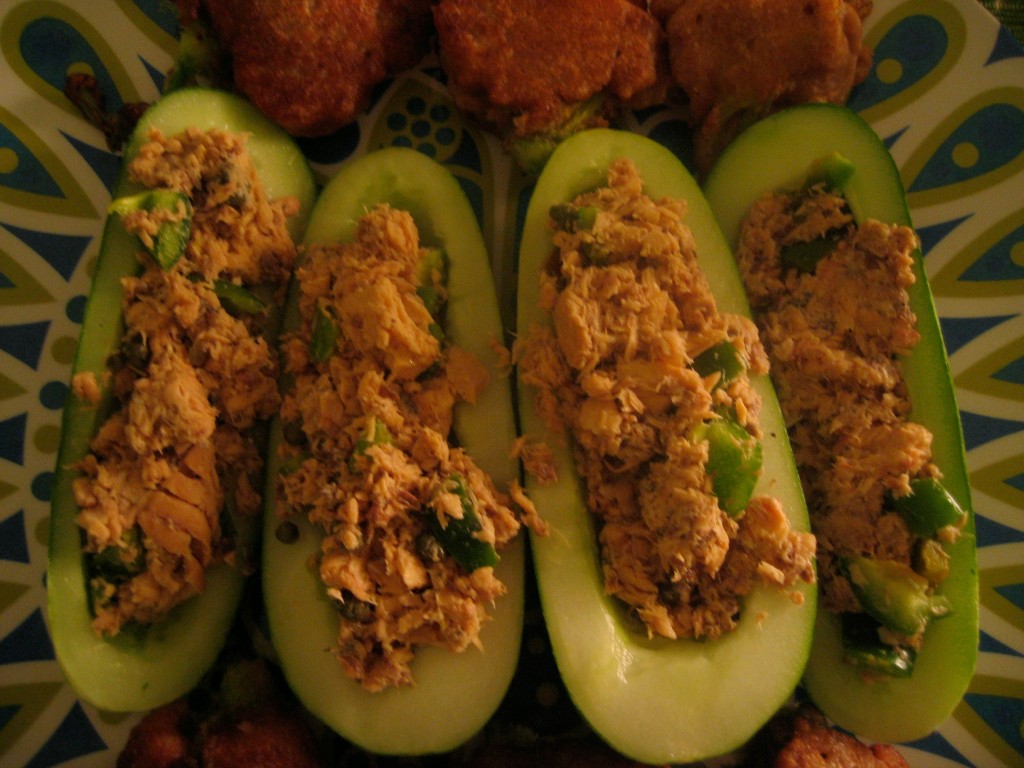 Like a delusional castaway on a deserted island, I’ve been seeing boats everywhere. Ever since writing about Zucchini Boats, my mind seems to have been opened to all the possibilities. Bananas, melons, bell peppers, mushrooms, tomatoes. It seems almost anything can become a “boat.”
Like a delusional castaway on a deserted island, I’ve been seeing boats everywhere. Ever since writing about Zucchini Boats, my mind seems to have been opened to all the possibilities. Bananas, melons, bell peppers, mushrooms, tomatoes. It seems almost anything can become a “boat.”
Cucumbers seem especially suited to boat-ness. Many people already make them without knowing it by scraping out the seeds. What’s left behind is the perfect cavity to fill with something delicious. In this recipe, I chose to fill it with a salmon salad. A nice addition to my recipe would be some grated Parmesan cheese. I didn’t add it this time because we were also having goat cheese stuffed squash blossoms, and I didn’t want a cheese overload.
I think I like these better than the zucchini boats. They are crisp, fresh, and easy. Perfect for summer because they require no oven. I suppose they are raw? If you consider canned salmon raw, I suppose . . . ? I’m not up on the rule book for Raw Foods. At the very least, these boats don’t require any actual cooking, only assembly.
And the best part? They are best eaten like a hot dog.
Cucumber Boats
2 cucumbers
1 can salmon, sustainably harvested if you can find it
1 lemon
2 Tbs capers
1-2 small bell peppers, any color
1/4 cup grated Parmesan cheese (opt.)
salt and pepper
Put the salmon in a medium bowl and break it into pieces. You can pick out the bones if you want. Zest the lemon over the bowl. Then roll it under you palm a few times to release the juices. Cut it in half and squeeze the juice into the bowl, straining the seeds through your fingers. Add the capers. Chop the peppers into small pieces and add them the to bowl too. If you’re using cheese, add it now too. Cover the bowl and set it in the fridge to chill for a bit. Cut the cucumbers in half lengthwise. Use a spoon to scrape out the seeds. Fill the cavity with the salmon salad. Eat with your hands, like a hot dog.